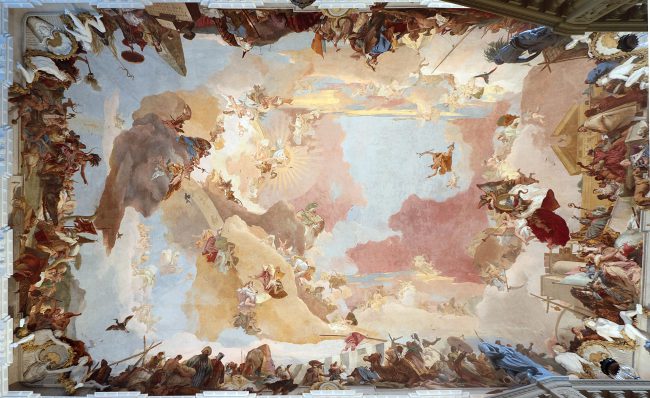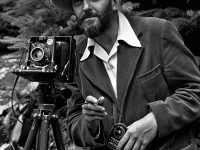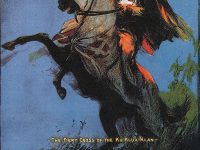
Giovanni Battista Tiepolo (1696 – 1770)
On March 5, 1696, Italian painter and printmaker Giovanni Battista Tiepolo was born. As an important member of the 18th-century Venetian school, Tiepolo painted in the Rococo style. His work includes depictions of heroic epics, histories, opera scenes, festivals of the gods, and also altars, where he enriched a number of these paintings with putti and cupids.
Giovanni Battista Tiepolo – Early Years
Giovanni Battista Tiepolo was born in Venice. He was the youngest of six children of his mother Orsetta and his father Domenico, who owned a small ship. Tiepolo was an apprentice to one of his mother’s brothers, but was more closely influenced by Giovanni Battista Piazzetta, who was fourteen years his senior and one of the most respected Venetian artists of the 18th century. Piazzetta was particularly famous for his genre scenes, as well as religious and mystical subjects, which were at the forefront of settecento Venetian painting. At the age of 17, Tiepolo was enrolled in the painters’ guild. At the age of 18, Giovanni Battista Tiepolo went into business for himself, and at 21 he became a master. He quickly achieved successes that made him a sought-after and famous painter. Among his patrons in Venice was the Bishop of Udine, Daniele Dolfin, who commissioned Tiepolo to paint some rooms in the Bishop’s Palace and other works.
Würzburg
From 1745 to 1750 Tiepolo was busy with works in Palazzo Labia in Venice. Afterwards he went to Würzburg with his two sons. This made Giovanni Battista Tiepolo, along with Titian, the most important Italian painter to travel to Germany and work there. The works in the Würzburg Residence are considered Giovanni Battista Tiepolo’s major work. In the staircase, a ceiling fresco completed in 1753 shows the four continents. In the Emperor’s Hall, the paintings show the marriage of Frederick Barbarossa and Beatrix of Burgundy, as well as the prince-bishop’s investiture with the rights of an imperial prince. Altogether, the Würzburg frescoes form a state painting spanning the earth.
The largest Ceiling Fresco in the World
The Würzburg Residenz is a baroque palace building on the outskirts of the city centre of Würzburg, which was begun in 1720 and completed by 1744. The interior of the Residenz, which was built during the Schönborn period under the direction of Balthasar Neumann,[2] was completed in 1781. The enormous complex of driveway and staircase is vaulted by the largest continuous ceiling fresco in the world (approx. 580 m²), painted between 1752 and 1753 by Tiepolo and his sons – especially Giovanni Domenico Tiepolo – and other helpers. Its main theme is the glorification of the master of the house, the prince-bishop, by the (then recognized) four continents. Karl Philipp von Greiffenclau zu Vollrads hovers in a medallion over Europe as the preserver and patron of the arts. He is celebrated by the whole world, which is symbolized by four female figures (=continents) riding on animals typical of their continent. As representatives of the arts, Balthasar Neumann (architecture), Antonio Giuseppe Bossi (sculptor/stucco artist) and Tiepolo (painting) are themselves also represented in the painting: Neumann riding on a cannon, an allusion to his position as colonel of the artillery of the Franconian district. Then Bossi with his tools of trade at his feet above the right staircase, and finally Tiepolo in the corner between Africa and Europe, dressed as an observer of fellow artists in a red coat and white scarf. Tiepolo received the handsome sum of 15,000 florins for the work, equivalent to 13 times the annual salary of Balthasar Neumann.

Giovanni Battista Tiepolo, ceiling fresco at Wurzburg Residence, (1752-53), photo: Myriam Thyes, CC BY-SA 4.0, via Wikimedia Commons
In addition, Tiepolo worked in Franconia on the “Adoration of the Magi” for the Baroque monastery church of Münsterschwarzach. After returning to Italy, Tiepolo worked with his son Giovanni Domenico Tiepolo on the Villa Valmarana ai Nani in Vicenza.
Last Years
Tiepolo experienced the end of his life in Madrid. He became more and more sidelined artistically because the classicism of the court painter Anton Raphael Mengs was becoming more and more prevalent. Thus, seven altarpieces for a church in Aranjuez were no longer installed. Too weak to return to Italy, Giovanni Battista Tiepolo died in Madrid on March 27, 1770.
References and Further Reading:
- [1] Balthasar Neumann – Refining Baroque Architecture, SciHi Blog
- [2] Levey, Michael (1980). Painting in Eighteenth-Century Venice (revised ed.). Cornell University Press.
- [3] Baxandall, Michael; Alpers, Svetlana (1994). Tiepolo and the Pictorial Intelligence. New Haven: Yale University Press.
- [4] Christiansen, Keith. Giambattista Tiepolo, 1696–1770, New York: Metropolitan Museum of Art, 1996.
- [5] Peter O. Krückmann: Tiepolo, Giovanni Battista. In: Neue Deutsche Biographie (NDB). Band 26, Duncker & Humblot, Berlin 2016, p. 268.
- [6] Timeline for Giovanni Battista Tiepolo, via Wikidata





